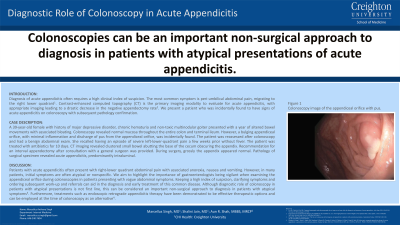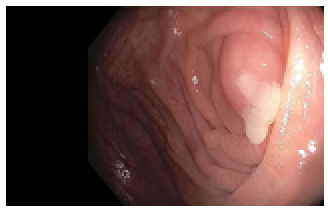Sunday Poster Session
Category: General Endoscopy
P0695 - Diagnostic Role of Colonoscopy in Acute Appendicitis
Sunday, October 27, 2024
3:30 PM - 7:00 PM ET
Location: Exhibit Hall E

Has Audio
- MS
Marcellus Singh, MD
CHI Health Creighton University Medical Center
Omaha, NE
Presenting Author(s)
Marcellus Singh, MD, Shalini Jain, MD, Aun R. Shah, MBBS, MRCP
CHI Health Creighton University Medical Center, Omaha, NE
Introduction: Diagnosis of acute appendicitis often requires a high clinical index of suspicion. The most common symptom is peri-umbilical abdominal pain, migrating to the right lower quadrant. Contrast-enhanced computed topography (CT) is the primary imaging modality to evaluate for acute appendicitis, with appropriate imaging leading to a drastic decrease in the negative appendectomy rate. We present a patient who was incidentally found to have signs of acute appendicitis on colonoscopy with subsequent pathology confirmation.
Case Description/Methods: A 39-year-old female with history of major depressive disorder, chronic hematuria and non-toxic multinodular goiter presented with a year of altered bowel movements with associated bloating. Colonoscopy revealed normal mucosa throughout the entire colon and terminal ileum. However, a bulging appendiceal orifice, with minimal inflammation and discharge of pus from the appendiceal orifice, was incidentally found. The patient was reassessed after colonoscopy and had a benign abdominal exam. She recalled having an episode of severe left-lower-quadrant pain a few weeks prior without fever. The patient was treated with antibiotics for 10 days. CT imaging revealed clustered small bowel abutting the base of the cecum obscuring the appendix. Recommendation for an interval appendectomy after consultation with a general surgeon was provided. During surgery, grossly the appendix appeared normal. Pathology of surgical specimen revealed acute appendicitis, predominantly intraluminal.
Discussion: Patients with acute appendicitis often present with right-lower quadrant abdominal pain with associated anorexia, nausea and vomiting. However, in many patients, initial symptoms are often atypical or nonspecific. We aim to highlight the importance of gastroenterologists being vigilant when examining the appendiceal orifice during colonoscopies in patients presenting with vague abdominal symptoms. Keeping a high index of suspicion, clarifying symptoms and ordering subsequent work-up and referrals can aid in the diagnosis and early treatment of this common disease. Although diagnostic role of colonoscopy in patients with atypical presentations is not first line, this can be considered an important non-surgical approach to diagnosis in patients with atypical symptoms. Furthermore, treatments such as endoscopic retrograde appendicitis therapy have been demonstrated to be effective therapeutic options and can be employed at the time of colonoscopy as an alternative.

Disclosures:
Marcellus Singh, MD, Shalini Jain, MD, Aun R. Shah, MBBS, MRCP. P0695 - Diagnostic Role of Colonoscopy in Acute Appendicitis, ACG 2024 Annual Scientific Meeting Abstracts. Philadelphia, PA: American College of Gastroenterology.
CHI Health Creighton University Medical Center, Omaha, NE
Introduction: Diagnosis of acute appendicitis often requires a high clinical index of suspicion. The most common symptom is peri-umbilical abdominal pain, migrating to the right lower quadrant. Contrast-enhanced computed topography (CT) is the primary imaging modality to evaluate for acute appendicitis, with appropriate imaging leading to a drastic decrease in the negative appendectomy rate. We present a patient who was incidentally found to have signs of acute appendicitis on colonoscopy with subsequent pathology confirmation.
Case Description/Methods: A 39-year-old female with history of major depressive disorder, chronic hematuria and non-toxic multinodular goiter presented with a year of altered bowel movements with associated bloating. Colonoscopy revealed normal mucosa throughout the entire colon and terminal ileum. However, a bulging appendiceal orifice, with minimal inflammation and discharge of pus from the appendiceal orifice, was incidentally found. The patient was reassessed after colonoscopy and had a benign abdominal exam. She recalled having an episode of severe left-lower-quadrant pain a few weeks prior without fever. The patient was treated with antibiotics for 10 days. CT imaging revealed clustered small bowel abutting the base of the cecum obscuring the appendix. Recommendation for an interval appendectomy after consultation with a general surgeon was provided. During surgery, grossly the appendix appeared normal. Pathology of surgical specimen revealed acute appendicitis, predominantly intraluminal.
Discussion: Patients with acute appendicitis often present with right-lower quadrant abdominal pain with associated anorexia, nausea and vomiting. However, in many patients, initial symptoms are often atypical or nonspecific. We aim to highlight the importance of gastroenterologists being vigilant when examining the appendiceal orifice during colonoscopies in patients presenting with vague abdominal symptoms. Keeping a high index of suspicion, clarifying symptoms and ordering subsequent work-up and referrals can aid in the diagnosis and early treatment of this common disease. Although diagnostic role of colonoscopy in patients with atypical presentations is not first line, this can be considered an important non-surgical approach to diagnosis in patients with atypical symptoms. Furthermore, treatments such as endoscopic retrograde appendicitis therapy have been demonstrated to be effective therapeutic options and can be employed at the time of colonoscopy as an alternative.

Figure: Colonoscopy Image of the Appendiceal Orifice with Pus
Disclosures:
Marcellus Singh indicated no relevant financial relationships.
Shalini Jain indicated no relevant financial relationships.
Aun Shah indicated no relevant financial relationships.
Marcellus Singh, MD, Shalini Jain, MD, Aun R. Shah, MBBS, MRCP. P0695 - Diagnostic Role of Colonoscopy in Acute Appendicitis, ACG 2024 Annual Scientific Meeting Abstracts. Philadelphia, PA: American College of Gastroenterology.
